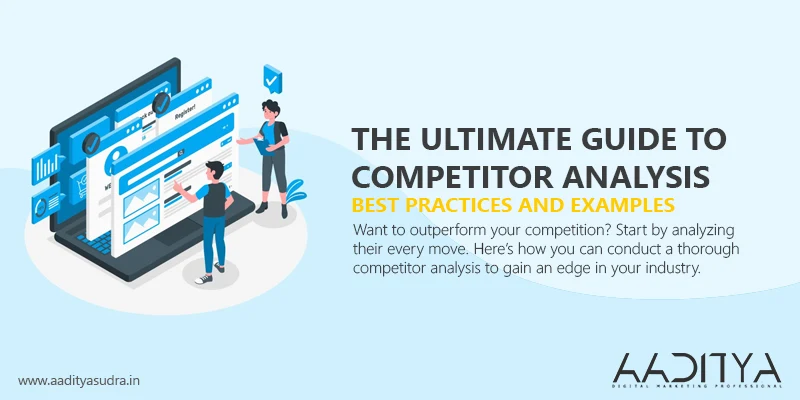The Ultimate Guide to Competitor Analysis: Best Practices and Examples
Table of Contents
- Introduction: Why Competitor Analysis is Crucial
- Step-by-Step Process for Effective Competitor Analysis
- Best Practices for Competitor Analysis
- Competitor Analysis Tools You Should Know
- Real-World Examples of Competitor Analysis in Action
- Conclusion: Use Competitor Analysis to Outpace Your Rivals
Want to outperform your competition? Start by analyzing their every move. Here’s how you can conduct a thorough competitor analysis to gain an edge in your industry.
Introduction: Why Competitor Analysis is Crucial
In today's hyper-competitive business environment, staying ahead of your competitors is essential for survival and growth. But how can you stay ahead if you don't know what your competitors are up to?
This is where competitor analysis comes into play. It's the process of researching, monitoring, and evaluating the strengths, weaknesses, opportunities, and threats posed by your competitors. By understanding their strategies, products, and services, you can identify gaps in your own business and seize opportunities they may have missed.
But there’s more to competitor analysis than just watching their every move. Done right, it can help you refine your marketing tactics, innovate your offerings, and ultimately outsmart your competition.
Step-by-Step Process for Effective Competitor Analysis
Ready to dive in? Here’s a step-by-step guide on how to conduct a comprehensive competitor analysis.
1. Identify Your Competitors
First things first—who are your competitors? Start by identifying both direct and indirect competitors. Direct competitors offer the same or similar products/services, while indirect competitors may solve the same problem for your target audience but with different solutions.
Tip: Use tools like Google Search, industry reports, and social media to identify competitors.
2. Analyze Their Products and Services
Once you've identified your competitors, the next step is to evaluate their products and services. Look at aspects like:
- Product features
- Pricing strategies
- Quality and customer feedback
- Unique selling propositions (USPs)
Tip: Pay attention to the value they provide and how they position themselves in the market.
3. Assess Their Marketing Strategies
Examine how your competitors are marketing themselves. This includes:
- Content marketing: Are they blogging, using video content, or running webinars?
- SEO: What keywords are they targeting, and how do they rank in search engines?
- Social media: Which platforms are they active on, and what kind of engagement are they getting?
- Advertising: What kinds of paid ads are they running?
Tip: Use tools like SEMrush, Ahrefs, or SimilarWeb to get insights into their traffic, keywords, and marketing strategies.
4. Analyze Their Audience Engagement
Your competitors' customer base can provide valuable insights. Examine how they engage with their audience on platforms like social media and through customer reviews. Look for:
- Audience demographics
- Engagement rates
- Customer complaints and praises
Tip: Dive into platforms like Facebook, Instagram, LinkedIn, or YouTube to observe how they interact with their community.
5. Perform a SWOT Analysis
Now, it's time to perform a SWOT analysis (Strengths, Weaknesses, Opportunities, Threats) of your competitors. This will help you understand:
- What they do well
- Where they fall short
- Untapped opportunities in the market
- Threats that could disrupt their or your business
Best Practices for Competitor Analysis
Competitor analysis is only valuable if done properly. Here are some best practices to follow:
1. Set Clear Objectives
Before you begin, define what you want to achieve with your analysis. Whether you're trying to refine your pricing, improve your content strategy, or enter a new market, having a clear objective will help you focus your efforts.
2. Keep It Regular
The market changes rapidly, so make competitor analysis a continuous process. Regularly check in on what your competitors are doing to ensure you’re not falling behind.
3. Benchmark Your Performance
Use competitor data to benchmark your own performance. If your competitors are seeing better results from their marketing efforts, it’s time to analyze why and adapt your strategy.
4. Stay Ethical
Competitor analysis should always be ethical. Avoid any practices that involve stealing intellectual property or engaging in deceptive behavior. Instead, rely on publicly available information.
Competitor Analysis Tools You Should Know
The right tools can make competitor analysis much easier. Here are some must-have tools:
- SEMrush: A comprehensive tool for tracking competitors' SEO, paid ads, and content marketing strategies.
- Ahrefs: Great for keyword analysis, backlink tracking, and content performance monitoring.
- SimilarWeb: Provides insights into competitors' web traffic, sources, and engagement metrics.
- SpyFu: Focuses on SEO and PPC analysis, helping you identify your competitors' most profitable keywords.
- BuzzSumo: Useful for content research and identifying which pieces of content are performing well for your competitors.
Real-World Examples of Competitor Analysis in Action
Example 1: Nike vs. Adidas
Nike and Adidas are two of the largest competitors in the sports apparel market. Both companies keep a close eye on each other's marketing strategies. When Adidas started focusing on sustainability, Nike quickly followed suit by promoting their Flyknit technology, which reduces waste during production.
Example 2: Coca-Cola vs. Pepsi
The Coke vs. Pepsi rivalry is legendary, and both companies conduct in-depth competitor analysis. Coca-Cola once used Pepsi’s failure in launching Crystal Pepsi (a clear soda) to create the now-famous New Coke, a marketing success.
Example 3: McDonald's vs. Burger King
In the fast-food world, McDonald's constantly monitors Burger King’s pricing, promotions, and campaigns. When Burger King launched its Whopper Detour Campaign—an app-based promotion offering a Whopper for just 1 cent if users were near a McDonald’s location—McDonald's responded with more app-based rewards and offers.
Think of competitor analysis like eavesdropping on a conversation at a party. You can learn a lot about what people are talking about without ever having to say a word! — Aaditya Sudra
Conclusion: Use Competitor Analysis to Outpace Your Rivals
Competitor analysis is not just a one-time activity—it’s an ongoing process that helps you stay competitive and refine your strategies. Whether you’re looking to improve your marketing tactics, refine your product offering, or gain insights into what your competitors are doing better, effective competitor analysis is key.
By consistently keeping an eye on your competitors and adopting best practices, you can not only stay in the game but get ahead.
Ready to boost your competitive edge? Start conducting competitor analysis today! Need help? Contact us to discuss how we can assist you in outperforming your competition.
FAQ's
Competitor analysis is the process of identifying, evaluating, and understanding your competitors' strengths, weaknesses, opportunities, and threats to improve your own business strategy.
It helps you understand the market landscape, spot gaps in your strategy, and find opportunities to outperform your competitors.
Tools like SEMrush, Ahrefs, BuzzSumo, and SimilarWeb can provide valuable insights into your competitors’ SEO, marketing, and content strategies.
Competitor analysis should be an ongoing process. Regular monitoring helps you stay up-to-date with industry trends and your competitors' latest moves.
Absolutely! By understanding your competitors' marketing strategies, you can refine your own campaigns, better target your audience, and discover new opportunities.













No comment